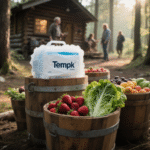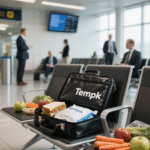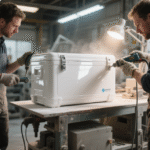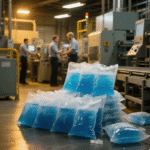You’re here to keep food truly frozen for three days. The fastest path: size your dry ice packs for shipping food 72 horas correctly, use vented packaging, and follow 2025 IATA/UPS/USPS rules. Frozen food is safest at 0 °F (–18 °C), and 1 lb of dry ice vents ~8.3 ft³ of CO₂—so never seal the box airtight. You’ll find a 2‑minute calculator, compliance checklist, and test plan below.
-
How much do you need? A quick way to size dry ice packs for shipping food 72 horas for real lanes.
-
How to pack safely? Vented packouts, food‐safe wrapping, and labeling that passes tender.
-
Which insulation wins? EPS vs. PUR vs. VIP for a 72‑hour hold with less weight and cube.
-
Quais são os 2025 rules? IATA PI 954, FedEx/UPS specifics, USPS 5 lb air limit.
How many dry ice packs for shipping food 72 hours do you need?
Short answer: Start at ~12 lb for a small frozen payload in a 1.5–2″ EPS shipper, then adjust for heat, isolamento, and payload mass. That baseline reflects field usage (≈5 lb first day, then 3–4 lb per extra day). Always pilot‑test and data‑log.
Why it varies: Heat gain comes from ambient temps, R‑value, void space, and starting payload temp. ISTA 7E provides 72/144‑hour parcel profiles to validate your design before scale.
Quick 2‑minute estimator (rule of thumb)
Example: 82 °F lane, EPS 1.75″, 8 lb payload → 12×1.2×1.0×1.2 ≈ 17.3 lb. Use this to right‑size dry ice packs for shipping food 72 horas, then confirm in chamber or live runs.
How to pack dry ice packs for shipping food 72 hours safely?
Core steps: Prefreeze to 0 °F, wrap food (no direct dry‐ice contact), place product centered, dry ice on top with side batts as needed, minimize headspace, ensure venting, then label/mark for the chosen mode.
Venting matters: Dry ice must off‑gas; do not make the liner or outer carton airtight. UPS and 49 CFR 173.217 both require ventilation; UPS also advises against airtight boxes.
Food‑safe and handler‑safe basics
-
No direct contact: Wrap/contain foods to avoid CO₂ burn.
-
PPE & ar: Gloves, eye protection, ventilado packout area; CO₂ TWA 5,000 ppm, IDLH 40,000 ppm.
-
Conversion reality: 1 lb dry ice → ~8.3 ft³ CO₂ gas; plan vent paths.
Quick packout bill‑of‑materials (BOM)
| Item | Purpose | Typical spec | Why it matters to you |
|---|---|---|---|
| Insulated shipper | Cut heat gain | EPS 1.5–2″ / PUR ~1″ / VIP ~1″ | R‑value drives dry‑ice mass. VIP often shrinks box & peso. |
| Gelo seco | Keep payload ≤0 °F | Slabs on top + side batts | Slabs last longer than pellets; top‑load for cold sink. |
| Forro & wrap | Food safety | Moisture barrier; double‑bag | Prevents direct contact & freezer burn. |
| Labels/marks | Acceptance | Aula 9 + “Dry Ice/UN 1845” + net kg | Required by IATA/air carriers; avoids tender rejections. |
Practical tips that cut melt risk
-
Fill voids so cold gas stays around product, not empty space.
-
Pre‑chill the empty shipper (overnight if possible).
-
Ship Mon–Wed to avoid weekend holds.
Real‑world case: A 2″ EPS shipper with 5 lb frozen payload held ~72 h using ~12–13 lb dry ice in summer validation, with a top slab and side batts.
Which insulation makes 72 hours easier with dry ice packs for shipping food?
Bottom line: Higher R‑value reduces dry‑ice mass and outer‑box size.
EPS vs. PUR vs. VIP—what changes for your 72‑hour plan?
| Isolamento | Typical R‑per‑inch | 72‑h likelihood | What it means |
|---|---|---|---|
| EPS | ~3.6–3.9 | Possible (more dry ice) | Lowest cost; larger cube. |
| PUR/PIR | ~5.3–6.3 | Strong candidate | Thinner walls; lower weight. |
| VIP | ~R‑30 (whole‑panel ≈R‑25–30) | Often 72–96 h+ | Smallest cube; less ice. |
VIP and VIP‑hybrids often close a marginal 72‑h gap without excessive refrigerant, which aligns with off‑the‑shelf 72–96 h VIP kits used in food and life‑sciences.
Carrier rules for dry ice packs for shipping food 72 horas (2025)
Air (IATA, FedEx, UPS): Usar IATA PI 954; vented packaging; apply Class 9 label; mark “Dry Ice” or “Carbon Dioxide, sólido,” UN 1845, and net kg. IATA’s 2025 acceptance checklist standardizes visual steps when no Shipper’s Declaration is required (for dry ice cooling non‑DG). FedEx 2025 job aids reiterate these marks and the per‑package maximum (often cited as 200 kg).
USPS (domestic air): 5 lb max dry ice per mailpiece with required Pub 52 markings; surface mail has different marks.
U.S. ground (49 CFR 173.217): Not treated as fully regulated if minimum vented‑packaging/marking rules are met, but follow carrier SOPs.
UPS reminders: Don’t seal airtight; label “Dry Ice/UN1845”; expect acceptance audits on some services.
Checklist you can follow today: Use vented packaging; apply Class 9; mark “UN 1845” + net kg on the same surface; train staff on current carrier/IATA rules.
Should you combine gel packs with dry ice packs for shipping food 72 horas?
Yes—gel packs buffer temperatures and can slow dry‑ice burn‑off, useful for sensitive textures or long hot lanes. Carriers recognize dry ice and gel packs as common cooling aids; Cardinal Health’s guidance notes the combo can extend duration.
2025 developments and trends in dry‑ice food shipping
What’s new: Wider availability of curbside‑recyclable paper liners that rival EPS; VIP kits marketed for 72–96 h; cheaper connected data loggers; and clearer acceptance checklists in IATA DGR 66th (2025). Plan smaller cubes with higher R‑value and verify with data.
At‑a‑glance
-
Recyclable liners make EPS‑like performance possible with greener disposal.
-
VIP + PCM systems extend hold while cutting cube and dry‑ice mass.
-
Validation is mainstream: 72/144‑h ISTA 7E profiles are the default for OQ.
Market snapshot (directional): Cold‑chain data loggers projected ~7–8% CAGR through 2030; insulated packaging continues steady growth mid‑single digits depending on region and segment. Use these as planning signals and confirm with your finance team.
Perguntas frequentes
Q1: What temperature is “safe” on arrival?
Frozen at 0 °F (–18 °C) stays safe indefinitely (quality may change). For refrigerado, stay ≤40 °F (4 °C). Use a probe thermometer at receipt.
Q2: Do I need a Shipper’s Declaration by air?
Not when dry ice cools non‑DG and PI 954 is met; still apply Class 9, UN 1845, and net kg, and ensure venting. Check your carrier job aid.
Q3: How do I avoid tender rejections?
Put UN 1845 + net kg on the same surface as the Class 9 label when space allows; meet minimum text sizes; keep the package vented.
Q4: What about CO₂ safety for my team?
Vent work areas; follow exposure limits (TWA 5,000 ppm; IDLH 40,000 ppm). Train staff and avoid sealed vehicles/rooms.
Q5: Can I ship with USPS?
Sim, domestically—5 lb max dry ice per mailpiece by air with Pub 52 markings.
Hands‑on calculator for dry ice packs for shipping food 72 horas
Use this quick formula, then pilot‑test under your worst lane:
Dica: Prefer slabs on top of the load; pellets sublimate faster.
Pro table: choose your packout parts
| Packout element | Bom | Better | Melhor | What it means to you |
|---|---|---|---|---|
| Isolamento | EPS 1.5–2″ | PUR ~1″ | VIP ~1″ | Higher R‑value → less ice & smaller cube. |
| Refrigerant | Dry ice slabs | Slabs + side batts | Slabs + VIP | Longer top‑zone cold, balanced burn‑off. |
| Monitoring | Single‑use logger | BLE logger | Cellular logger | Faster root‑cause on excursions; proof for claims. |
| Labels & marks | Class 9 + UN 1845 | + net kg same face | + carrier job‑aid sizes | Smooth acceptance at counter/scan. |
Field‑tested tips
-
Scenario—hot lane (>90 °F): Add 20–40% dry ice or move from EPS to PUR/VIP.
-
Texture‑sensitive foods: Buffer with gel packs around sides; keep dry ice on top only.
-
Documentação: Keep SOP with photos of label placement and vent tabs.
2025 validation plan for dry ice packs for shipping food 72 horas
-
Projeto: Select EPS/PUR/VIP and initial dry‑ice mass using the estimator.
-
Profile: Qualify against ISTA 7E (summer worst‑case). Target ≥10% margin.
-
Pilot: Run two live shipments Mon–Wed; log temperatures; adjust +/– 2–4 lb.
-
Train: Refresh staff on PI 954 / 49 CFR 173.217 / carrier job aids.
























